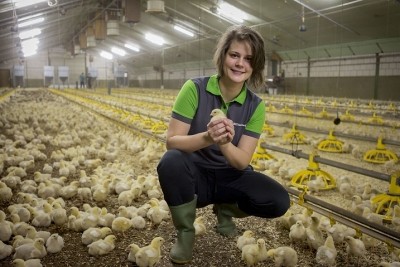Special Edition: Gut Health
Career profile: One industry player's road from pharma to vaccines to feed

The Nutreco executive has authored numerous papers on porcine health and immunology and holds a DVM from the University of Santiago de Compostela, in Spain. He is also a resident of the European College Porcine Health Management (ECPHM) Diplomates.
What is your background?
I am a vet by training; I finalized my veterinary medicine degree in Spain in 1998. I first worked with companion animals, but, after a period, I [shifted into] swine production, as a practitioner in the field, working with swine integrators. During that time, I also collaborated with consultants, developing technologies for farming.
I subsequently moved to the pharmaceutical industry; I worked in Novartis [in a senior management role]. I also attended business school during that period and started some biotechnology start-ups; from there, I jumped into the immunology world – vaccines. In 2012, I moved into the feed additives business, with Trouw Nutrition, and that is what I have been doing for the past five years.
Why did you make the switch into the feed additives sector?
When I was a practitioner in the field, nutrition was seen as [playing a key role in animal performance]. I was always very interested in nutrition, even on the human side. In fact, I did a post-graduate in human nutrition. So really, a move into that area was the [natural] next step in terms of developing my career. When you see the holistic approach we use now incorporating feed, farm, and health, it makes sense. Nutreco was, for me, a company that had a very good image, from the animal nutritional side.
Is your pharma, immunology, and nutrition profile unique in the industry then?
I do not consider myself unique! However, in general, it is not easy to find people who have been working in the field, and who have, at the same time, a health background and a feed background.
When approaching customers, it is [an asset to be able] to understand their needs from the feed, farm and health point of view.
When we have the feed right and the environment correct, then, normally, the health status [of the animal] is better. What we want to do is evaluate whether the animal is in good condition, whether the gut health is optimal for vaccination, for example.
Feed [can influence] the health of the gut. You can use the best vaccines in the world, but if the animal is not prepared [in terms of immune response] for that vaccination, I can tell you the vaccine is not going to work. We need to balance both sides, to ensure the animal has a good immune status and that the vaccines used combine a good antigen with a good adjuvant.
We need to prepare the animal in terms of everything related to feed; we need to have good pellet quality and good digestion; [we need to] manage the microbiota of the animal, and manage the absorption of the nutrients, [and combine this with] good farm management - from welfare to temperature control and the whole environment of that animal – so as to decrease as much as possible its stress levels.
What exactly is the role of global program manager for swine gut health?
As a program manager, I am always connected with the R&D people, as a business leader, guiding them to find a solution that matches the needs of the customers. I am also involved in marketing, and I train the sales teams – we have the Trouw Nutrition Academy [which aims at business and operational excellence and leadership development].
Travelling is time consuming. I travel a lot - China, Spain, US, Brazil and Mexico are my five focus countries. This year, I have also visited [customers] in Australia and Vietnam. In that way, I am in constant contact with customers, trying to understand their requirements. You could say I am in the middle of the whole business chain.
How is your division performing?
In general, we are growing around 20% above the average growth rate (AGR) of the [global feed additives] market. This growth is related to the three pillars of our integrated strategy – feed, farm, and health – that are connected to expertise, services and products.
We have a swine production [unit] in Spain [comprising] 85,000 sows and two million pigs; that facility gives us an added advantage as we can validate our programs and that is very important [in terms of product development.]
What is the hardest thing about your job?
I think it is, partly, the jet lag!
Joking aside, from the business aspect, the most difficult aspect is how to transmit the message from the customers to our researchers in a way they understand what the market needs; My role is to make the business case and get it approved by the board. Sometimes, they [the researchers] have a fantastic, scientific mind but they are thinking [theoretically]. Transforming the message from the field, from the customers to that scientific mind is not always an easy [task].
Have you found shortcuts to get around that communication challenge then?
It depends on each person. It is quite complex. Some researchers are more open to innovation, they are [more willing] to think outside of the box, while others do not feel as comfortable [with such an approach]…. I try to motivate people. I try to change their minds. I try to explain [the rationale] and to provide examples on how certain approaches will open doors and allow us to achieve our business targets, particularly when we are starting our standardized R&D process from idea to feasibility to the development stage.
I think the most important thing to do is to bring them to the field. When you bring a researcher to the field and they can see what the customers are saying, or [hear directly] what the customer wants, then it is much easier to convince them of the path we need to take.
If you could have one 'do-over' in your career, what would that be?
Nothing. I have no regrets. I have learnt a lot from my mistakes, more so than from what I have done right. Of course, if I could go back, maybe I could do it better.
How challenging is it to attract graduates to the agribusiness sector?
I think it is quite difficult. If you checked in now with students enrolled in universities, in terms of veterinary medicine, you would probably find that 80 to 85% want to work with companion animals. Livestock production – swine or even poultry production – is not attractive enough. We need to [promote the industry more.] We are not showing how important we are.
When I talk with friends, for example, they are not aware of how feed can make an impact on aspects like food safety, like antimicrobial resistance (AMR) and, subsequently, on human health.
I am a total believer in the One Health concept, and I think, in the future, there will be joint courses in human medicine and veterinary medicine.
If we can show the next generation the potential, and if we can show them that you can produce pigs or chickens using new technology, that the work is totally different to the past, if we can change their perception of the farmer, then, perhaps, we can attract them [to the livestock production sector].
Do university courses reflect the skillset required by the industry today?
In general, yes. My colleagues are doing a lot of R&D and validation work on feed with the key universities, the leaders in animal nutrition, and they are addressing the needs of the market.
What is the feed additive sector’s biggest challenge right now?
I think the challenge is to fully understand the mode of action of feed additives, particularly now with the knowledge we have about how antibiotics function. We also need to develop new molecules, while continuing to learn what we can do with the existing additives, always addressing the needs of the customers.









